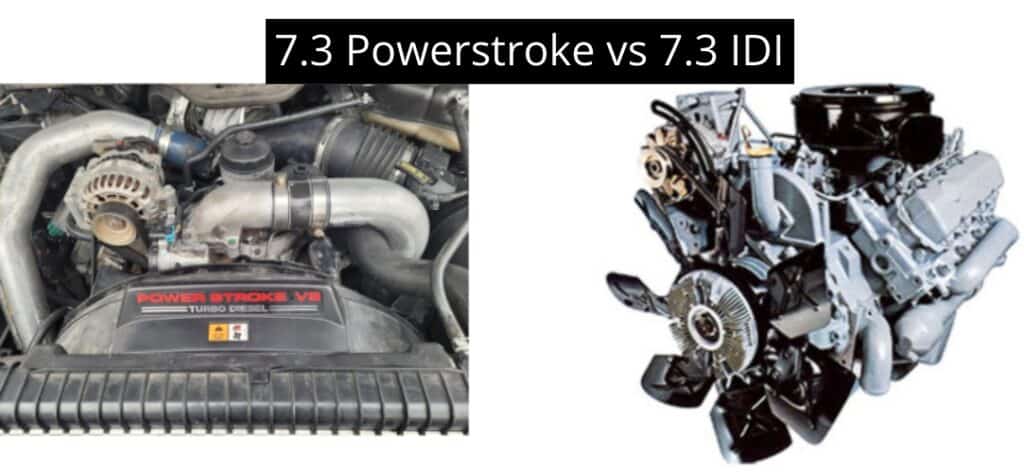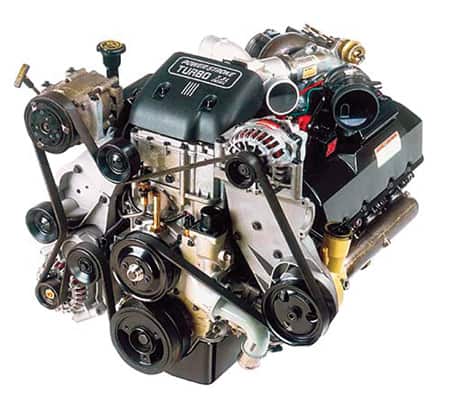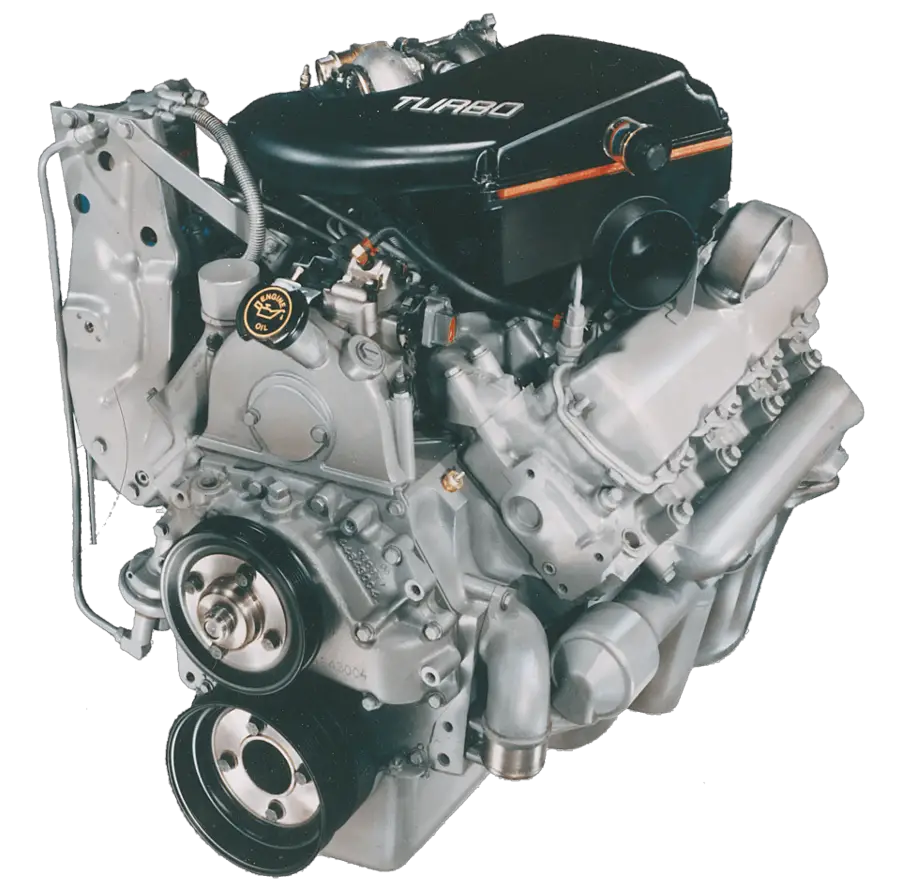
The 7.3 liter Powerstroke and the 7.3 liter International Harvester IDI (indirect injection) are two robust Diesel engines from 1988-2004 and were once used by Ford in many of their trucks. The IDI is the older engine, though other differences between the two are also notable.
The 7.3 IDI did not use sensors to regulate function (whereas the newer Powerstroke did). Essentially, the IDI worked using mechanical fuel injection in contrast with the power stroke, which uses electronic fuel injection. The Powerstroke also produced more power and provided better fuel economy.
None of these facts are meant to put down the older IDI (1988-1994). Both engines have very reliable track records, especially when preventive maintenance is involved. Powerstroke and IDI engines with over 350,000 miles (563,270 km) are not uncommon.
7.3 Powerstroke vs. 7.3 IDI (Side-by-Side Comparison)
| Engine | 7.3 IDI | 7.3 Powerstroke |
|---|---|---|
| Production | 1988-1994 | 1994-2004 |
| Fuel Economy | 12-13.5 MPG (5.1-5.7 Km/L) | 15 MPG (6.4 Km/L) |
| Horsepower | 180-190 hp/3000 RPM | 275 hp/2800 RPM |
| Pound-feet of Torque | 388/1400 RPM | 525/1600 RPM |
| Mileage | 350,000-500,000 miles (563,270-804,672 km) | 200,000-350,000 miles (321,869-563,270 km) |
If you happen to be in the market for an older Ford truck featuring one of these engines, the best choice for you depends on a few things:
- How many miles does the truck have on it already?
- How well has the truck/engine been cared for?
- Is the IDI engine naturally aspirated or turbocharged?
- Do those few extra miles in fuel economy bother you?
If you expect to work on your engine—whether for modification or repairs—the IDI is the wiser choice. However, if you’re looking for something more modern and with more power, go with the Powerstroke.
As long as the truck and engine have been properly cared for, you’re unlikely to go wrong with either choice. Both engines are workhorses that owners are passionate about. This is one of those engines that will run practically forever when well cared for.
The 7.3 Ford Powerstroke Engine
The 7.3 Powerstroke was a turbo Diesel engine produced from 1994 to 2004 as a replacement for the IDI.
It appeared in Ford’s F-Series Super Duty trucks, the Excursion SUV, and its E-Series vans. This engine turned out to be one of the most reliable Diesel power plants ever used.
The 7.3 Powerstroke even won kudos from “rival” enthusiasts of other engines, and to this day, buyers of older Ford trucks seek out this engine.
As with the IDI, Ford teamed up with Navistar International to develop the Powerstroke. This move was made primarily to keep pace with refined U.S. emission standards of the time without sacrificing power.
The 7.3-liter Powerstroke ceased production in 2004 (again, U.S. emission standards were changing, and Ford needed to change with them). It put out 275 horsepower at 2800 RPM and had a peak torque range of 525 pound-feet (711.8 Nm) at 1600 RPM.
The International Harvester IDI Engine
IDI stands for indirect injection. Diesel engines with indirect injection do not have fuel injected directly into the combustion chamber. The 7.3 IDI is considered among the last of great “non-sensor module” engines ever produced.
Rather, the fuel goes into a pre-chamber instead. This pre-chamber exists inside the cylinder head. Indirect injection also sprays fuel into the intake valves (unlike direct injection), resulting in a cleaner burn and lower carbon build-up on the engine parts.
The 7.3 IDI was a four-stroke, naturally aspirated V8 Diesel used by Ford from 1988 to 1994 (with a turbocharged version becoming available in 1993). This engine is among the final Diesel mechanical ones ever produced.
It was built by International Harvester (which would eventually become Navistar) to provide Ford with a lightweight diesel engine and help the company keep pace with Dodge and General Motors, both of whom were building popular trucks at the time.
The 7.3 IDI was replaced by the 7.3 Power Stroke in 1994. It delivered 180-190 horsepower (depending on whether or not you had the turbo variant, which was called the Navistar T444E), with 388 foot-pounds (526.1 Nm) of torque at 1400 RPM.
7.3 Powerstroke: Pros & Cons

The Powerstroke filled the position left by the IDI very neatly. It put out over 60% more horsepower, providing about 15 miles per gallon (6.4 km per liter) compared to the outgoing engine’s 13.5 miles per gallon (5.7 km per liter).
Still, it did have its drawbacks. Here are some pros and cons of the 7.3 Powerstroke.
Pros
- Powerful and dependable, with 50% of production units lasting over 350,000 miles (563,270 km)
- Low pressure throughout a power stroke (the point where the piston is propelled by expanding gas), which results in less stress on the engine
- Easy to accessorize and upgrade
Cons
- Can suffer from turbo lag
- A bit on the noisy side (especially when compared to its 6-liter counterpart)
- Cam position sensors fail too often for some drivers
Let’s examine each of the above cons in turn to give you a better idea of what you’ll be facing with the Powerstroke and how it differs from the IDI cons coming up soon.
Turbo Lag
Turbo lag is a condition where an engine’s turbocharger does not start doing its work until the inner turbine is spinning fast enough. As more air plumes pass through the intake, the turbocharger warms up, and the turbine spins faster, providing the “turbo boost” for the vehicle.
The Powerstroke’s powertrain control module (PCM) reduces turbo lag by helping cold engines warm quicker, though once the engine is warm, PCM backs off, allowing turbo lag to sometimes be a problem at lower speeds.
Noise
The 7.3 Powerstroke runs a bit loud, and not just because it’s a diesel engine. These engines use an HEUI injection system—which stands for Hydraulically Activated Electronically Controlled Unit Injector.
HEUI systems do not use multiple injections—or pilot injections—to quiet the process. Rather, they use just one injection. Without a pilot injection to reduce noise, Powerstroke drivers typically have to deal with much noisier engines.
Problematic Sensors
Camshaft position sensors detect which engine cylinder is firing in order to synchronize the fuel injector and firing sequence. Ignition timing relies on these position sensors to create optimal engine performance.
When camshaft position sensors fail, the check engine light turns on, the vehicle loses fuel mileage, begins to run erratically, and stalls at odd times.
All of the above problems are common with the 7.3 Powerstroke, though they are not enough to detract from its overall critical praise. But does the older IDI engine do better or worse?
7.3 Indirect Injection: Pros & Cons

While the IDI isn’t as powerful or economical as its successor, fans speak fondly of its bulletproof performance and friendly-to-work-on approach.
Pros
- More mechanical than electronic, making it easy to repair
- Non-turbocharged versions were especially tough, with many still working today
- Can run for half a million miles or more
Cons
- It’s an old engine, making spare parts a bit difficult to find.
- Is susceptible to cavitation
- Naturally aspirated versions tend to lose power at high elevations.
Spare Parts Are Rare
The first issue is a major one for IDI owners. Because the engine hasn’t been in production since the early 90s, about the only parts owners can get are aftermarket—and even those can be tricky to find. Still, the IDI is easy to work on once you do find the parts.
Cavitation
Cavitation is an issue for all Diesel engines, but even more so with the IDI. Cavitation happens when vacuum bubbles are created in a liquid due to an external force.
In the IDI’s case, that force comes from the expansion and contraction of the fiercely-pressurized cylinder walls.
As the cavitation reduces, engine coolant is allowed makes contact with the cylinder walls, causing damage. Coolant additives can prevent this phenomenon and are recommended for all Diesel engines.
Weaker Performance at High Elevation
Naturally aspirated engines like the older IDIs depend fully on atmospheric pressure for their air intake.
With air pressure being much lower the higher you go, naturally aspirated systems become less able to deliver power through the intake.
Taking an IDI engine to levels over 10,000 feet (3,048 m) results in very weak performance that alarms many drivers.
Conclusion
The 7.3 Powerstroke and the 7.3 IDI have their differences in power output, mileage, and lifespan. Still, if you find one of these engines in good condition, you’ve pretty much hit the jackpot.
Lovers of Ford trucks will debate to the moon and back which power plant is better—and it’s been my experience that when debates like this happen, it means both are pretty great. Regarding the Powerstroke and the IDI, nothing could be closer to the truth.
